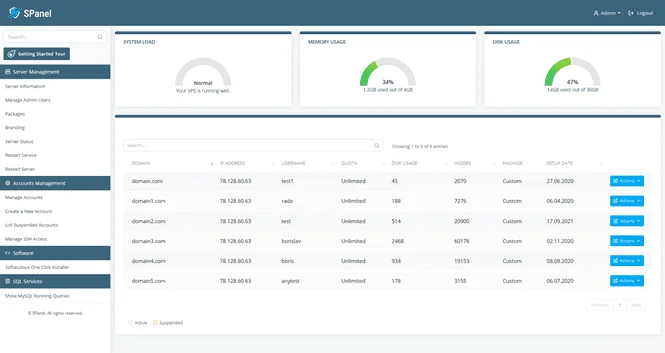Although a command-line shell can be a powerful tool, many people can’t imagine using a hosting service without a control panel.
However, with more and more different alternatives popping up on the market, it’s getting increasingly difficult to find the panel that best suits your needs.
SPanel is one of the relative newcomers, and it appears to be gaining traction with more and more people. It’s billed as an alternative to cPanel, but can it really be as good as a tried-and-tested management tool that has been around for 25 years?
Let’s find out.
What Is SPanel?
SPanel is an all-in-one web hosting management system developed and maintained by ScalaHosting. Scala had had the idea of creating their own control panel for a while, but when cPanel announced its pricing policy changes in 2019, the need for an alternative became all the more apparent.
Managed VPS plans are central to ScalaHosting’s business, so it’s no surprise that SPanel was designed with virtual servers in mind.
Just like cPanel/WHM, you can use it to control both the server and the projects hosted on it. It has a sleek interface that is extremely easy to get used to, and you are left with the sense that nothing is out of place.
Scala is leaning on over a decade of experience, and they continue to improve the platform by adding new features to all descriptions. They’re willing to get their customers involved, as well.
There’s a platform where SPanel users can log in and request new features or vote for tools that have been ordered by other customers. The requests with the most votes eventually make it to SPanel’s interface.
So, Scala uses the invaluable knowledge of the people who interact with SPanel to steer the platform in the right direction. If they continue to do so, the future is going to be bright.
But what about the present? How does SPanel compare to the current people’s favorite: cPanel?
How Does SPanel Work?
SPanel consists of two parts: the Admin Interface and the User Interface.
The Admin Interface is the equivalent of cPanel’s WHM. By default, you can access it via the https://[your server’s IP]/spanel/ URL and use it for server maintenance tasks like:
- monitoring the server’s load and health
- checking and restarting services
- monitoring MySQL queries
- rebooting the server
Your other main job as an admin user is to set up individual accounts for the websites you host on the server. You can edit account quotas, suspend or delete projects, and decide who gets to have SSH access.
The rebranding options and ability to use a custom logo also make SPanel an appealing proposition for resellers.
The interface is pretty easy to navigate around, but just in case, you also get a Getting Started tour that can walk you through all the different sections.

When the time comes to build a website and everything around it, you need to go to https://[your domain name]/spanel/ and access SPanel’s User Interface.
Compared to cPanel, the homepage is less cluttered, but you still have everything you need to efficiently manage your project.
You get free access to the Softaculous one-click installer, so you can set up a website-building application and start work immediately. After that, you can use SPanel’s tools to create and manage:
- email accounts
- files
- databases
- subdomains
- DNS records
- FTP accounts
- backups
- SSL certificates
- cron jobs

With all these tools and features, site maintenance should be pretty straightforward, even for less experienced users.
What’s Next for SPanel?
Currently, SPanel is only available with ScalaHosting’s managed VPS plans. However, due to high demand, the company has decided to start selling it to the general public. A release date hasn’t been confirmed yet, but in the foreseeable future, you will be able to use SPanel both on Scala’s VPSs and on your own server.
But do you want to do it?
It’s definitely worth considering it. Anyone who has had any experience with cPanel should have no problems getting used to the interface, and even if this is your first time getting to grips with a control panel, the learning curve will be non-existent.
ScalaHosting has thought about pretty much all aspects of server and website maintenance, and they continue to refine and optimize the platform. This is the sort of progress you want to see from a worthy cPanel competitor.
 Get Listed
Get Listed 


